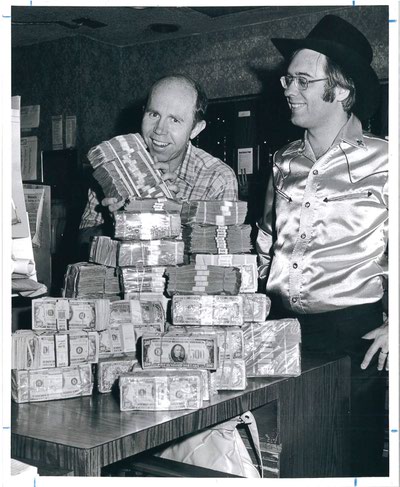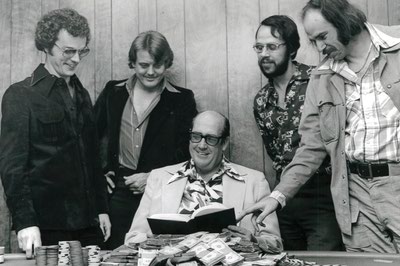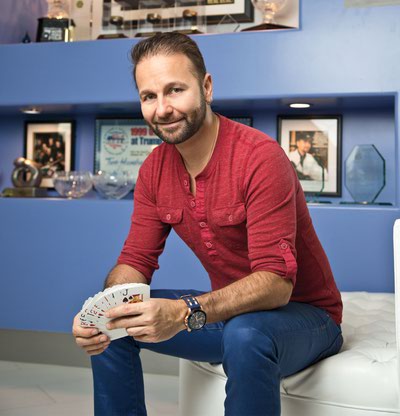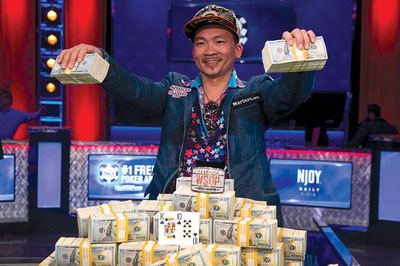Thursday, June 13, 2019 | 2 a.m.
Doyle Brunson and Bryan “Sailor” Roberts, two eventual world champions of poker, are in mid-conversation, facing away from the camera. Other poker-playing peers are chomping on cigars or obscured behind colleagues wearing cowboy hats in the back of Binion’s Horseshoe.
As with many historic photographs, it’s immediately evident that most of the depicted subjects don’t comprehend the gravity of the moment. The picture was taken at the conclusion of the 1970 World Series of Poker (WSOP), after seven out of the roughly 30 assembled gamblers had voted Johnny Moss the best all-around player, and therefore by default, the game’s first world champion. The captured moment still wields influence—current World Series of Poker executive director Ty Stewart has a print of it displayed on a poster board in his home.
“I like to have that inspiration, something to look back on,” Stewart says. “So much of poker is behind closed doors, and that’s OK, but our role is to bring it out into the light.”
The 50th-annual World Series of Poker began in late May at the Rio with the set of 89 championship tournaments running through mid-July. The Main Event—the $10,000 buy-in that annually determines the overall champion to follow in Moss’ footsteps—begins on July 3 and lasts 10 days, with the final table airing live on ESPN.
The 2019 series also marks the 15th year since Caesars Entertainment purchased the WSOP from Binion’s and moved the event from a cramped Downtown casino floor to a spacious convention center just off the Strip. Much has changed with the relocation.
Around 8,000 players are expected for the Main Event, a tournament that once drew as few as six entrants. Plumes of cigarette or cigar smoke are no longer the foremost table hazard, replaced by overly loud headphones on the heads of some players. The ringing of surrounding slot machines has ceased, giving way to a 24/7 chorus of shuffling chips.
But Stewart, who’s in his 14th year as a WSOP executive, hopes the spirit remains intact, and he’s not the only one. The same picture he displays also hangs at the local home of Daniel Negreanu, the third-winningest WSOP player ever in terms of earnings with $17.2 million in prize money.
“I’ve just always loved the history,” Negreanu says. “When I started out, the World Series was just a dream to be a part of. Now I’m lucky enough to have the luxury to be able to play in all the events I want, but it’s still what I look the most forward to, because it still brings all the best gamblers to one place.”
Concentrating the world’s best gamblers in one place was always the intention of the World Series of Poker, which has origins dating back further than the widely cited 1970 start date.
In essence, the first WSOP was held the year before in Reno, when Holiday Hotel owner Tom Moore invited all the top poker players to his property for a weekend he dubbed “the Texas Gambling Reunion.” He hoped the high rollers would boost his casino’s bottom line during an otherwise slow period.
By the numbers
$2.99 billion Prize money awarded through 49 years of the World Series of Poker, with $1.95 billion of the total coming in the past decade alone
42.27 Average participant age at the 2018 World Series of Poker
$8.8 million First-place prize at the 2018 Main Event, won by high-stakes cash-game professional John Cynn
$74 million Prize pool for the 2018 Main Event created through the $10,000 entry fee from 7,874 players, 1,182 of which finished in the money to secure a payout
104 Countries represented at the 2018 World Series of Poker through its 78 total events
$655,337 Average first-place prize money for winning a 2018 World Series of Poker tournament
15 Bracelets won by poker professional Phil Hellmuth, who holds five more than any other player. Doyle Brunson, Johnny Chan and Phil Ivey have each won 10
18 Countries to have produced a bracelet winner at the 2018 World Series of Poker
1,410 World Series of Poker bracelets awarded through 2018, with a record 89 more to be handed out in tournaments this summer
They didn’t, as players like Brunson and Binion’s Horseshoe proprietors Benny Binion and Jack Binion stayed glued to the poker tables instead of the more-profitable-for-the-house table games. When Moore made it clear he wasn’t interested in making what had turned into a poker marathon an annual event, the Binions swooped in and co-opted the same basic format for their own casino in Las Vegas.
“They could not possibly imagine how successful that idea would be and what kind of tree would grow from that little seed,” Brunson wrote in his autobiography, The Godfather of Poker. “I don’t think anyone could have.”
Brunson also recalled that Benny Binion saw potential in the WSOP, however, and that informed a set of fateful ensuing decisions. The 1970 event went roughly the same route as the 1969 Texas Gambling Reunion, with a series of cash games followed by a vote to determine the best player. And then Benny Binion decided a change was necessary. The World Series of Poker needed a more decisive way to crown a champion and attract media attention.
Benny Binion introduced the tournament format still used today in 1971, when Moss prevailed again over five other competitors. In 1972, Moss bowed out of the seven-player field early, and a final three of Brunson, Amarillo “Slim” Preston and Puggy Pearson emerged.
Brunson had a chip lead but was allowed to cash out of the tournament in a move at the time blamed on a stomachache. But in his book, Brunson later revealed the real reason for his forfeit: He didn’t want any publicity as the champion, so the players struck a deal allowing Preston, who sought fame, to prevail.
The 1972 tournament remains one of the most controversial moments in the history of the WSOP—and an undeniable one in terms of impact. Brunson wrote that he believed the event would have ceased in a few years without Preston, who became a celebrity through a number of talk-show appearances, including as a recurring guest on The Tonight Show Starring Johnny Carson. Tales like Preston’s have gripped WSOP newcomers ever since.
“I had a lot to learn about the history of the WSOP,” Stewart says, reflecting on his decision to commit to work exclusively on poker in 2005. “But I was happy to do that, and I quickly found it fascinating.”
Under Stewart, the WSOP has used “where dreams are dealt” as one of its main slogans—implying that anyone can win any given event. That promise wasn’t fully realized until the WSOP was nearly a decade old. Although the number of entrants increased every year following Preston’s win and media tour, established professionals were victorious in the first eight Main Events, including Brunson going back-to-back in 1976 and 1977.
That changed in 1979, when a California advertising executive, Hal Fowler, outlasted a field of 54 players to win the $270,000 first-place prize. He never cashed in another WSOP event, but he laid the groundwork for many winners to come.
The largest jump in participation in the WSOP’s first 20 years came in 1984, when the field expanded from 108 to 132 players in the aftermath of Tom McEvoy’s win. Unlike Fowler, McEvoy was a professional, but he was a relatively unknown one from Grand Rapids, Michigan, and he became the first player to win without putting up the full $10,000 entry fee.
In 1983, the WSOP had introduced satellite tournaments, where players could win their way into the Main Event field at a lesser cost. McEvoy beat out nine other players in a $1,000 mini-tournament and eventually turned it into the $580,000 Main Event winner’s share. In his postgame interview after defeating fellow up-and-comer Rod Peate heads-up, McEvoy called out the established poker pros—mentioning Brunson by name—as having new competition.
“Two little-known players made the pros sit up and take notice,” commentator Curt Gowdy signed off the CBS special broadcast. “They also brought some new excitement to the World Series, proving once again that the hometown Friday-night poker player does have a chance for his moment of glory in the rarefied air of high-stakes poker.”
CBS gave the WSOP its first television visibility through the early 1980s, but the event got its biggest boost when it switched to ESPN in time for what many still consider the greatest feat in Main Event history. Johnny Chan won the tournament in 1987 and 1988, later immortalized in 1998 cult-classic film Rounders, before finishing second in 1989 to then 24-year-old Phil Hellmuth, the youngest-ever champion at the time.
“I was 16 years old and saw the clips of Phil Hellmuth and Johnny Chan on ESPN and got goose bumps,” Negreanu says. “It was so real, and I had such an affinity for it. I wanted to get there.”
McEvoy’s win may have inspired a handful of new WSOP participants, and the combination of Chan and Hellmuth might have spurred hundreds, but that paled compared to the thousands brought to the event by Chris Moneymaker.
The 2003 World Series of Poker is often regarded as the most important moment in the history of the event. Moneymaker, a then 27-year old accountant from Nashville, Tennessee, won the Main Event title and $2.5 million after securing his entry through an $86 online satellite victory.
“I enjoyed being around for Moneymaker, but I had no idea it was going to result in the way it resulted,” ESPN color commentator Norman Chad says. “I was sort of oblivious to all that. It didn’t even feel right to me until I saw the first couple episodes of the show before we voiced it, and then, seeing the viewership increase with every episode. That’s hard to do. I remember just going, ‘That’s incredible.’”
Poker had infiltrated the mainstream and soon seemed to be on ESPN at all hours. In hindsight, the indicators were readily apparent even before Moneymaker won.
The proliferation of online poker had made the game more accessible worldwide, and ESPN had spruced up its production value just in time. It was the first year pairing Chad and Lon McEachern, who showed natural chemistry in the broadcast booth and are now as synonymous with the WSOP as any players. Most importantly, ESPN introduced hole-card cameras, so viewers could see what hands players were holding and better understand the betting action.
“It seems impossible to say this, but I really did believe this game could turn into something like this,” Negreanu says. “I think a lot of players saw the vision and possibility of hole cards creating a boom. Because if you watch poker and don’t see the hole cards, then what are the guys doing? When you see the cards, it creates kind of an anxiety, an anticipation that isn’t available when you otherwise don’t get them.”
Moneymaker proved the perfect avatar to show off the power of the nascent hole-card cameras. It made for riveting television to see everything from his mistakes—such as when he knocked out top-rated pro Phil Ivey in 10th place with a far inferior hand—to his brilliant bluffs, like when he got veteran Sammy Farha to surrender the winning hand in a massive pot heads-up.
Moneymaker was a breakout star and poker was exploding, but beneath the glitz, there were issues. Binion’s had started a descent into financial ruin after the death of Benny Binion in 1989, with rumors spreading that the 2004 WSOP wouldn’t even take place.
It ended up happening, but when 2,576 players signed up for the Main Event—a sizable increase from the 839 entrants the year before—some felt like it shouldn’t have. Binion’s didn’t have sufficient space, and Chad remembers arriving to cover the tournament and finding tables in the basement, outside and across the street.
“It was fun to be at Binion’s,” Chad says. “Binion’s felt like Las Vegas … but Binion’s felt old. It felt used. It felt like no one had vacuumed the carpets since at least the lifetime of Benny Binion.”
Caesars (then Harrah’s) acquired the WSOP before the 2005 event, moving it to the Rio, just west of the Strip. There, it gained the room and stability it needed as participation continued to rise.
That doesn’t mean everything has remained steady over time. The Main Event peaked with an all-time high of 8,773 players in 2006 before suffering a downturn of more than 2,400 entrants the following year.
The tightening of online gaming laws, which have excluded satellite victors like Moneymaker in 2003 from directly winning their way into the field, has primarily been cited as the cause. But the biggest blow to the poker community came on April 15, 2011, when the U.S. Justice Department effectively shut down the online industry with a $3 billion criminal indictment.
“Black Friday,” as it’s now referred to in poker circles, locked up hundreds of millions of players’ dollars amid litigation to indirectly increase the barrier of entry for WSOP events.
“The world is a much different place for poker right now, and there were some dark days where I was concerned about the future,” Stewart says. “But I think it made our whole team much more motivated that we could help and put a positive face on for poker. I think that’s what we’re most proud of—that we turned a corner of where it looked like poker, the World Series of Poker, would retract, and instead we’ve been able to get to new heights.”
The WSOP has set records in overall number of entrants—the combined number in all of its tournaments—in four of the past five years, peaking at 123,865 in 2018, largely because of its preponderance of smaller buy-in tournaments. The year before Caesars took over, the lowest-priced open events were a pair of $1,000 buy-ins. This year, there are 23 tournaments with a price tag of $1,000 or less.
“We’ve sort of opened the doors to everyone, and that was a major challenge,” WSOP executive Seth Palansky says. “Everyone is protective of this event as their own, but I think we’ve found a way to appease everyone while not alienating anyone.”
Most professionals were outspoken against the idea of holding tournaments at such a low price point, arguing that it diluted the prestige of the WSOP. Stewart and Palansky understood but retorted that they were aiming to do what was best for poker. They believe getting more players at the tables ultimately benefits everyone.
Some high-stakes gamblers remain skeptical, while others have come around. “I think the best thing the World Series has done is be adaptable to the ever-changing landscape of poker,” Negreanu says. “I think they’ve done great at turning what was kind of a seedy, backroom-type game into something that’s corporately acceptable and also catering to the buy-ins of the majority. I was always against the idea of lower than $1,500 buy-ins, but I’ve started seeing the positives from a business perspective.”
The first major tournament to kick off this year’s WSOP was the recent Big 50, $500 buy-in with no rake (the percentage the house typically takes) that set a live-tournament record with 28,371 entrants. The event, which software engineer Femi Fashakin won to earn $1.4 million, was Stewart’s brainchild, intended to honor the history of the WSOP. But he doesn’t think it went far enough.
He’s been told the 1970 photograph he looks at on a near-daily basis was taken after an annual buffet the Horseshoe offered to anyone who participated in a tournament during the early years of the WSOP. That wouldn’t be possible to replicate now—Stewart jokes that feeding 50 people was a bit easier than feeding 50,000—but an alternate version could take its place.
The WSOP will hold its First Fifty Honors Gala June 29 at the Rio. Chad and McEachern will host an awards banquet recognizing winners of fan-voted categories, like the four most important players in WSOP history and the most impressive Main Event victory. Anyone who’s ever won a WSOP bracelet—awarded to the winner of every official tournament—is invited for a complimentary dinner. That means the current guest list is around 1,100 players, including almost all of the luminaries from the past half-century.
Stewart has high hopes the vast majority of them will attend, and he knows exactly how he’d like to end the night. “What do I want for the 50th?” he asks. “I’d like to break records, sure, but really, I want a great picture with all the legends. And I want whoever is managing this thing 50 years from now to have that.”
10 Local legends
Living in Las Vegas used to be a virtual necessity for those looking to pursue a career in professional poker. That’s no longer the case, as the game’s global expansion and online poker have combined to allow players to settle almost anywhere they want.
Still, the Vegas Valley remains home to a large number of notable card players, including these 10 legends from a variety of backgrounds and eras.
Doyle Brunson, Bracelets: 10, WSOP Lifetime Earnings: $3,083,079
“The Godfather of Poker” relocated to Las Vegas after starting his career as a Texas road gambler nearly 50 years ago and has played in the biggest games in town ever since. The 85-year-old notched his 37th career WSOP cash at last year’s series—coming in sixth in a 2-7 lowball draw tournament—but now says he’s retired from tournament poker.
Erik Seidel, Bracelets: eight, WSOP Lifetime Earnings: $5,439,236
For several years, Negreanu and Seidel battled for the spot atop poker’s all-time earnings list. They currently sit in second and third, respectively, behind Justin Bonomo, but Seidel’s $35 million is nothing to scoff at, nor are his pair of U.S. Main Event final table appearances.
Daniel Negreanu, Bracelets: six, WSOP Lifetime Earnings: $17,206,678
“Kid Poker” won his first WSOP title 21 years ago and has yet to slow down, commanding a crowd of spectators on a daily basis during the summer at the Rio. He’s the second-winningest live tournament poker player of all-time with $39.8 million in career earnings, including in events outside of the WSOP.
Scotty Nguyen, Bracelets: five, WSOP Lifetime Earnings: $6,000,014
“The Prince of Poker” is the only player to have won both of the WSOP’s two most prestigious annual tournaments—the Main Event and the $50,000 buy-in Poker Player’s Championship. His unheeded warning of, “You call, it’s going to be all over, baby,” to Kevin McBride on the final hand of the 1998 Main Event stands as one of the most memorable moments in WSOP history.
Antonio Esfandiari, Bracelets: three, WSOP Lifetime Earnings: $22,283,326
“The Magician” is the WSOP’s all-time earnings leader, largely because of his $18.3 million victory in the first-ever $1 million buy-in event in 2012. He only decided to enter the tournament at the last minute, having previously agreed to serve as a commentator on the action for ESPN.
Doug Polk, Bracelets: three, WSOP Lifetime Earnings: $4,539,609
Despite a relatively brief, seven-year career playing live tournaments, Polk sits just outside the top 50 in all-time earnings. He retired from poker last year to focus on cryptocurrency, in which he's regarded as an expert.
Jen Harman, Bracelets: two, WSOP Lifetime Earnings: $1,485,033
Another breakout star from the early 2000s, the UNR graduate was a staple in both televised poker shows and the highest-stakes cash games during the period. Many consider her the greatest female poker player of all-time.
Qui Nguyen, Bracelets: one, WSOP Lifetime Earnings: $8,028,914
Nine of the last 10 Main Event champions were at least relatively known poker professionals. Nguyen is the lone exception. The former nail salon owner turned a $1,100 satellite tournament entry into $8 million at the 2016 WSOP with an unorthodox, gambling-heavy style.
Ben Lamb, Bracelets: one, WSOP Lifetime Earnings: $7,243,796
Some thought it impossible for anyone to make the Main Event final table more than once after fields expanded to thousands of players 15 years ago. Lamb is one of three players to have proven them wrong, coming in third place in poker's world championship in 2011 before finishing ninth in 2017.
Kathy Liebert, Bracelets: one, WSOP Lifetime Earnings: $1,304,418
Liebert is regarded as a pioneer, as her career stretches back nearly 30 years—to a time when hardly any women were staples on the poker circuit. She has a long history of success in the Main Event, with two 17th-place finishes and two other Main Event cashes of more than $30,000.
This story originally appeared in the Las Vegas Weekly.






